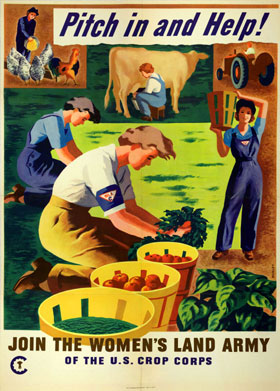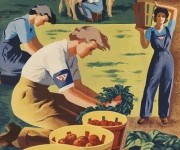 1943 poster: Special Collections, National Agricultural LibraryThe literary critic William Deresiewicz once identified a kind of rule-of-one in U.S. popular culture:
1943 poster: Special Collections, National Agricultural LibraryThe literary critic William Deresiewicz once identified a kind of rule-of-one in U.S. popular culture:
Like a poor man’s Noah, we take one of each. One physicist: Stephen Hawking. One literary theorist: Harold Bloom. One radical social critic: Noam Chomsky. Before her death, we had one intellectual, Susan Sontag, and one only. (Now we’ve dispensed with the category altogether.) We are great anointers in this country, a habit that obviates the need for scrutiny. We don’t want to have to go into the ins and outs of a thing — weigh merits, examine histories, enter debates. We just want to put a face on it — the logic of celebrity culture — and move on.
Deresiewicz doesn’t mention it, but the anointed one is usually a man. Things are no different in the sustainable food movement. We have our sage (Michael Pollan), our eminence gris (Wendell Berry), our star small farmer (Joel Salatin), our genius urban farmer (Will Allen), and our local-food chef (Dan Barber). The role of restaurateur Alice Waters, like Waters herself, is more vague, yet vital: she has become the face of the Edible Schoolyard movement.
Alice is not the only prominent woman in the food movement, although you might think so sometimes from the mainstream media’s coverage. There are other powerfully influential female figures: the Indian physicist and polemicist Vandana Shiva and NYU nutritionist Marion Nestle, whose 2002 book, Food Politics (along with Eric Shlosser’s 2001 Fast Food Nation) mapped out the terrain in which I now operate as a writer. And of course Frances Moore Lappé, author of the 1971 bestseller Diet for a Small Planet, who has been joined in her important work by her daughter and fellow author, Anna Lappé.
Women dominate the staffs of many of the most critical food- and farming-focused NGOs. They run farms (check out the book and website Farmer Jane), work as farmhands, and operate terrific local-food restaurants. They run important blogs (see Ethicurean, Civil Eats, and La Vida Locavore) and more. A woman has even ascended to the position of Grist food editor, moving me into the role of senior food writer. [Editor’s note: Don’t feel sorry for him. Tom more or less hired me to free him up to do more of his stellar reporting.]
As my girlfriend recently pointed out to me, the whole “vote with your fork” ethos that has dominated the food movement for decades is arguably a permutation of one of ’70s-era feminism’s central insights: “The personal is political.”
The public acknowledgment of women’s role in the movement has fallen short, argues Jennifer Cognard-Black in the cover story of the current (summer 2010) issue of Ms. magazine (not online, sadly). Cognard-Black demonstrates the centrality of women in the ongoing effort to challenge the industrial food system; and she adds a fact I hadn’t seen before:
In the 2007 U.S. Census of Agriculture, the total number of women operating farms increased 19 percent, far surpassing the overall 7 percent increase in farmers.
Clearly, women don’t lack recognition due to a lack of contribution, either in the field, in political organizing, or in the written word. It can only be subtle, ingrained sexism — the failure of people in media to highlight women’s contributions. The effects are stark. The Op Ed Project, which seeks to encourage more women to write more opinion pieces, has collected these eye-opening statistics: Men write more than 80 percent of op-eds published and comprise 84 percent of guests on Sunday morning political TV talk shows; 85 percent of Hollywood producers; 85 percent of nonfiction best-selling book authors; and 83 percent of Congress.
Cognard-Black’s essay got me looking into another recent piece on a similar topic: Charlotte Druckman’s wonderful “Why are there no great women chefs?” [PDF], in the Winter 2010 Gastronomica. Druckman’s title is facetious, an echo of Linda Nochlin’s seminal 1970s essay, “Why Have There Been No Great Women Artists?” Nochlin concluded that the lack of recognition for women in art had nothing to do with gendered differences in artistic ability, and much to do with the institutions that define greatness in art. To put it simply: The men who control the prestigious art magazines and university art programs define greatness in a way that excludes women.
Druckman does something similar with the high-end food world. There are no female analogues to “great” chefs like Thomas Keller, Daniel Boulud, and David Chang, Druckman writes, not because women lack skills or creativity at the stove; but rather because they lack the cultural power enjoyed by men in media circles.
The answer, it seems to me, is that people with media power — including me in my modest perch at Grist — have to rethink the prestige we unthinkingly heap on men and withhold from women. And we also have to reject Deresiewicz’s rule of one.
Diversity is a virtue in all things — not just on the farm field.


